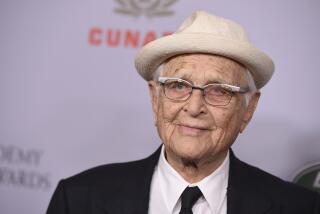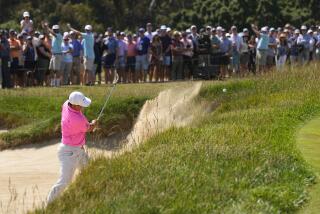Norman Is Ready for Major Try
- Share via
SOUTHAMPTON, N.Y. — If you knock on the door long enough and hard enough, sooner or later you’re bound to get in.
That’s the way Greg Norman, the 31-year-old Australian, looks at his chances of winning a major golf championship.
Three times--first, in the 1984 U.S. Open; next, a month later in the British Open, and then last month, in the Masters--Norman knocked hard enough to be heard, but not, apparently, hard enough to get in.
In ‘84, Norman tied Fuzzy Zoeller at Winged Foot in the memorable towel-waving incident where Zoeller thought Norman had won the Open with a 40-foot birdie putt on the final hole--not knowing that the miraculous putt he had witnessed from down the fairway had been to save par.
“I thought I’d won it, too, when I made that putt,” Norman recalled Wednesday after a practice round at the wind-swept Shinnecock Hills Golf Club, where the 86th U.S. Open will get under way today. “I’ve had winning a major championship as one of my priorities since I first turned professional, and that was as close as I can come without winning.”
The next day, in an 18-hole playoff, Zoeller shot a 67 and won easily.
At St. Andrew’s, in the British Open, Norman led the first day with a 67 and finished with another 67, but in between had 74-74 and lost by six shots to Severiano Ballesteros.
“I don’t think I ever entered a major championship with as much confidence as I had that week,” he said. “This week, I feel the same way. I am hitting the ball extremely solid, and my level of confidence has never been higher.”
At the Masters, Norman was tied with Jack Nicklaus when he strode to the 72nd hole, but he bogeyed the final hole and missed a playoff.
Since the Masters, however, the long-maned Aussie--who did not play golf until he was 16--has been on a tear. Instead of mulling over his misfortune after Augusta, Norman became the hottest player in golf by winning two tournaments--the Panasonic Las Vegas Invitational and the Kemper Open--and missed winning another by a stroke.
Going into the Open, Norman is in the same mode he was two years ago.
As he did in ‘84, Norman won the Kemper, skipped the Westchester and came to the Open with a hot hand.
“It’s a nice feather to have in your cap, to win a couple of tournaments and be playing as well as I have the last six or eight weeks,” he said. “I came here knowing I’d been playing well, and I’ve played extremely well (in practice) the last couple of days. I hope I can keep it up.”
Although scores weren’t kept, Nicklaus estimated that Norman “shot something like a 65 yesterday (Tuesday).” Norman said he didn’t know the score, but did admit that he had six birdies and won the money in the match.
“Norman hit the ball so solid and got it so close to the hole that he couldn’t help but make birdies,” Nicklaus said. “I don’t recall seeing anyone hit the ball any better than he has in a long time.”
Said Norman: “I’m driving the ball extremely well and I think that’s the key to this golf course, more so than most Open courses where you can’t use a driver very often. This course has smaller greens than most courses, but it plays very long, which makes the drive more important in setting up the hole. It’s very important to be straight off the tee, straight and long, and that’s how I’ve been hitting it.”
The tour statistics back up Norman’s assessment of himself.
He not only leads the tour in earnings with $447,109 in 12 tournaments but is also second statistically in such disparate accomplishments as driving distance, at 277.3 yards, and putting, at 1.745 putts a hole.
“I don’t know which one I’m hitting better, my driver or my putter,” he said. “I’ve been very pleased with both. I found the putting stroke that hadn’t been working the last 12 months and now I have that feeling that I can make every putt I stand over. That’s a great feeling, and it definitely carries over into your stroke.”
Despite six early-season tournaments in which he missed the cut once and never finished better than 27th, Norman’s yearly stroke average of 70.08 is bettered only by Bernhard Langer’s 70.06 and Calvin Peete’s 70.07.
Norman also leads the tour in eagles and par breakers. In 48 rounds he has 10 eagles and 219 birdies.
If there was a flaw in his game before this year, it was his inability to win playoffs. He had been in three and lost them all--to Mike Nicolette at Bay Hill in 1983 in his first tournament as a PGA Tour member, to Zoeller in the 1984 U.S. Open and to Tom Watson in the Western Open the same year.
Two weeks ago, after six excruciating playoff holes in the Kemper, Norman put that jinx behind him by beating Larry Mize.
The big difference between today and a few years ago, or even a few months ago, Norman said, is his mental approach to the game.
“I don’t think my game has changed since 1976,” he said. “I think my mental approach, my shot-to-shot approach to the game, is the difference. I can see how my maturity level has changed in the last 18 months to make me a much better player.
“Before, when I hit a shot into the rough, I’d try to knock the next shot on the green even when I had no chance. Now, I have more patience. I hit the ball out in the fairway where I can set myself up for a pitch and a putt for par. This way, I’m not as spectacular, but I make fewer mistakes and don’t go for those high scores.”
Here at Shinnecock, out on the eastern tip of Long Island, the most-discussed topic among the players was the wind, an erratic breeze that sweeps across the course from the nearby Atlantic Ocean.
“From what I’ve seen here the last few days, it’s going to take a good wind player to survive,” Norman said. “I feel fortunate that I’ve played in a lot of windy conditions like this back home in Australia.
“When the wind shifts, it can change all your thinking in a hurry. Take No. 3 (a 453-yard par-4), for instance. Yesterday, the wind was coming off the (Long Island) Sound, and we used a driver and a 3-iron. Today, with the wind coming from the other way, it was a driver and a pitching wedge.”
Norman was not without criticism of the way the U.S. Golf Assn. laid out the course.
“I think No. 6 (a 471-yard par-4) is very unfair, especially with the wind blowing like it was today,” he said. “We played off the very front of the back tee today, and Hale Irwin barely reached the fairway. It was 230 yards, and he had to hit another driver for his second shot. Not only is the hole 471 yards long, it has the narrowest fairway on the golf course.
“I hit a driver and 3-wood, and so did Jack. Andy (Bean) hit a driver and 1-iron, and we’re not the shortest hitters out there. I don’t know what players like Calvin Peete or Mike Reid will do if the wind blows the next four days the way it did today. I don’t think they could get to the fairway.”
One thing Norman does like is that Shinnecock Hills is virtually a virgin course as far as the players are concerned. It has never been a tour site, and the last time the U.S. Open was here was 1896, when the course was on the other side of the Long Island Rail Road tracks.
“No one has any advantage here, because it’s not like they’ve played an Open here in the last 10 years or so and some guys are more familiar with the course,” he said. “We all came here on the same level, except Jack (Nicklaus), who’s been here two weeks working on getting ready. The rest of us have been here three or four days, learning the driving targets and the putting surfaces, so we’re all equal.”
Not really. When you’re 6-1, weigh 185 pounds and can drive the ball 277 yards on the average and putt like a magician--as Greg Norman can--there’s nothing equal about it.
More to Read
Go beyond the scoreboard
Get the latest on L.A.'s teams in the daily Sports Report newsletter.
You may occasionally receive promotional content from the Los Angeles Times.










